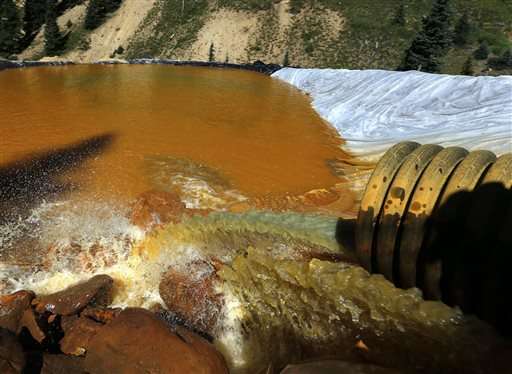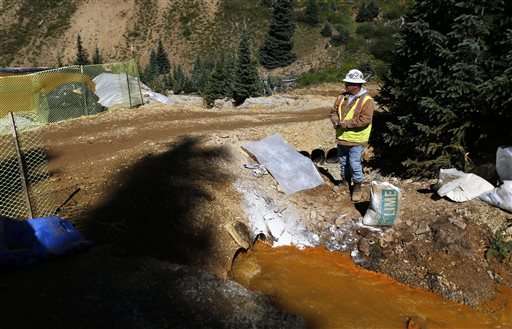In this Aug. 14, 2015 file photo, water flows through a series of sediment retention ponds built to reduce heavy metal and chemical contaminants from the Gold King Mine wastewater accident, in the spillway about 1/4 mile downstream from the mine, outside Silverton, Colo. Southwestern Colorado officials say they're ready to talk to the Environmental Protection Agency about a Superfund cleanup of inactive mines, including the one in Silverton that spewed millions of gallons of wastewater into rivers in August. (AP Photo/Brennan Linsley, file)
Southwestern Colorado officials said Friday that they are ready to talk to the Environmental Protection Agency about a federally financed Superfund cleanup of inactive mines, including one that spewed millions of gallons of wastewater and polluted rivers in three states this summer.
It would be an important step toward cleaning up hundreds of idle mines that have been pouring acidic wastewater into the Animas River north of Silverton for years. No laws required mine operators to mitigate environmental damage, and in many cases, the owners simply walked away when mining ceased.
"It's a direction we're heading in," San Juan County Administrator Willie Tookey said of a Superfund designation.
Some residents of the tourism-dependent community are wary of a Superfund listing, fearing it could discourage visitors, depress property values and take years to resolve. But the Aug. 5 spill at the Gold King Mine increased pressure to act.
The spill tainted rivers in Colorado, New Mexico and Utah, including the Navajo Nation and the Southern Ute Reservation. Towns, farmers and rafting guides had to temporarily stop using the rivers.
An EPA-led crew inadvertently triggered the spill. The crew was trying to insert a pipe into debris covering the mine entrance to gradually drain water backed up inside, but the debris gave way, unleashing a torrent.
Silverton and San Juan County officials looked into alternatives to a Superfund cleanup but found few options because of the cost, expected to be in the millions of dollars.
In this Aug. 14, 2015 file photo, an Environmental Protection Agency contractor keeps a bag of lime on hand to correct the PH of mine wastewater flowing into a series of sediment retention ponds, part of danger mitigation in the aftermath of the blowout at the site of the Gold King Mine, outside Silverton, Colo. Southwestern Colorado officials say they're ready to talk to the Environmental Protection Agency about a Superfund cleanup of inactive mines, including the one in Silverton that spewed millions of gallons of wastewater into rivers in August. (AP Photo/Brennan Linsley, file)
"There really isn't another process out there that could provide the financial resources for the environmental mitigation that's needed," Tookey said.
The Silverton Town Board and San Juan County commissioners are expected to vote Monday on resolutions that would formally open discussions with the EPA and state officials on a Superfund designation.
The EPA and the state have said they would not initiate a Superfund cleanup unless residents agreed.
Town and county officials visited four existing Superfund sites in Colorado this month and found that the process could be difficult but successful.
"When it's all said and done, the improvements wouldn't have been able to happen without Superfund, and ultimately it was worth the effort," Tookey said.
Some of idled mines north of Silverton are nearly 150 years old.
© 2015 The Associated Press. All rights reserved.























